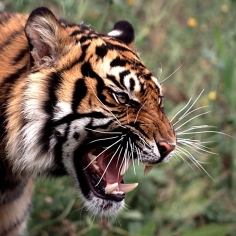You can either stop reading now because that’s the answer to the question, or you can continue and find out a little more detail.
I’ve just had an extremely pleasant experience reading John Terborgh‘s latest Perspective in PNAS. You know the kind of paper you read that (a) makes you feel smart, (b) confirms what you already think, yet informs you nonetheless, and (c) doesn’t take three days to digest? That’s one of those.
Toward a trophic theory of species diversity is not only all of those things, it’s also bloody well-written and comes at the question of ‘Why are there so many species on the planet when ecological theory can’t seem to explain how?’ with elegance, style and a lifetime of experience. I just might have to update my essential-ecology-papers list. If I had to introduce someone to 60 years of ecological theory on biodiversity, there’s no better place to start.
To the meat (sorry, bad pun). The essay starts off by outlining the problem — according to classic, ‘bottom-up’ ecological theory going back to the original Lotka-Volterra models, the reason proffered for why there are so many species is that resource limitation imposed by finite carrying capacity and interspecific competition means that species can co-exist. He then encapsulates the essential element: a conclusion resting on the notion that many (100s to 1000s, depending on habitat) of species have more or less equivalent competitive rank maintained stably over generations and across all biomes (which is essentially what is proposed by Hubbell‘s neutral theory — something I maintain has wasted nearly 15 years of ecologists’ time) does not have any supporting empirical evidence. So why do we cling to the idea that competition and carrying capacity alone allow so many species to co-exist?
Bottom-up theories assume that for coexistence to occur, most species in a community have to be near carrying capacity: that nebulous theoretical threshold of population density that can be supported by the available resource supply (other sources of mortality excluded). John sums up the fantastical notion of this concept beautifully in this quote:
“Carrying capacity has thus evolved into a scientific ghost — something everyone thinks is important but that one has ever seen.”
John systematically breaks down just how ridiculous this is, and something that I’ve struggled with for years both theoretically and empirically. He points out that bottom-up theories require that most species be near carrying capacity, even though the available evidence suggests that most species occupy their niches at more like an average of 10% of resource-limited ceilings.
Following this argument, he demonstrates how Robert MacArthur‘s ‘niche compression hypothesis‘ is also largely without empirical demonstration, mainly because most species are generalists and not restricted to finite habitat boundaries that might explain the difference between high tropical versus low temperate diversity.
Most importantly, John demonstrates in study after empirical study just how manipulating predator densities (either via experimentation, which is difficult at broad scales, or via comparison of places where predators have been reduced for other reasons) can release both mesopredators and mid-trophic omnivores, thus resulting in destabilised trophic interactions and ultimately, lower overall species diversity. This is known as ‘top-down’ regulation of biodiversity.
Such trophic cascades are well-known these days, yet there are those who still struggle to understand why predation is the key to all the wonderful biodiversity we enjoy today, and strive to protect. One proviso is of course that just like uncontrolled herbivory, too much predation (so called ‘super-predators’, like humans) can have the opposite effect, such as when a novel (often invasive) predator is released into a system where the constituent species do not have the evolved behavioural repertoire to limit their predators’ efficiency. As such, you can have a nonlinear relationship between predation rate and diversity (see Figure 1 in John’s paper) — in other words, there is a predation ‘sweet spot’ where biodiversity is maximised.
I’ve said it before, and I’ll continue to shout it out loud, especially with well-written essays like this for ammunition, that without predators our hyper-biodiverse realms are doomed to become mere ghosts of their former selves. Keeping your predator guild intact and healthy is an essential component of any long-term conservation success.




[…] del mundo y los principales depredadores de América Latina. Esto significa que son esenciales para mantener saludables a los ecosistemas. Sin embargo, están desapareciendo rápidamente en algunas partes de su área de […]
LikeLike
[…] in the world and the top predators across Latin America. This means that they are essential for keeping ecosystems healthy. However, they are disappearing rapidly in parts of their […]
LikeLike
[…] distribution and coexistence of species are of course dictated by many things: food availability (energy), biogeography, habitat availability, predation, climate, disturbance, […]
LikeLike
[…] sometimes result in a lot of wasted time. For example, in conservation ecology we’ve had to suffer 15 years of wasted effort on disproving neutral theory, we’ve bashed heads unnecessarily regarding the infamous SLOSS (‘Single Large Or […]
LikeLike
I love predators, and I’m sure they’re important elsehwere…but just wanted to point out that in Hawai’i, a very diverse fauna and flora evolved largely in the absence of predators…unless you count eating invertebrates as predation…
LikeLike
Yes, but very different ecological processes work on islands compared to continents. A lack of predators on small islands favours niche specialisation via heavy competition.
LikeLike
[…] https://conservationbytes.com/2015/09/23/what-makes-all-that-biodiversity-possible/ […]
LikeLike